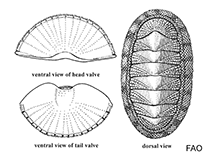Chiton tuberculatus Linnaeus, 1758
West Indian green chiton| Native range | All suitable habitat | Point map | Year 2050 |

|
| This map was computer-generated and has not yet been reviewed. |
| Chiton tuberculatus AquaMaps Data sources: GBIF OBIS |
Upload your photos
Google image | No image available for this species;
drawing shows typical species in Chitonidae.
Google image | No image available for this species;
drawing shows typical species in Chitonidae.
Classification / Names Common names | Synonyms | CoL | ITIS | WoRMS
Polyplacophora | Chitonida | Chitonidae
Environment: milieu / climate zone / depth range / distribution range Ecology
Benthic; depth range 0 - 4 m (Ref. 2022). Tropical
Distribution Countries | FAO areas | Ecosystems | Occurrences | Introductions
Western Central Atlantic: USA, Colombia, Bermuda, Mexico, Venezuela and the West Indies.
Length at first maturity / Size / Weight / Age
Maturity: Lm ? range ? - ? cm Max length : 7.6 cm TL male/unsexed; (Ref. 281)
Short description Morphology
Valve color: Dull grayish green or greenish brown; Some valves, dark-brown arrow-shaped patch on the dorsal ridge. Lateral areas: Five irregular, radiating cords. Central areas: Smooth at the top and eight to nine strong, wavy, longitudinal ribs on the sides. Girdle color: Alternating zones of whitish, green or black. Scales: Appear to be slightly higher than broad (Ref. 281).
Epibiotic (Ref. 110502). Very common under rocks, in the zone between tides (Ref. 292); intertidal to shallow subtidal (Ref. 289); intertidal and spray zones of rocky shores (Ref. 2022).
Life cycle and mating behavior Maturity | Reproduction | Spawning | Eggs | Fecundity | Larvae
Members of the class Polyplacophora are mostly gonochoric. Life cycle: Eggs hatch into lecitotrophic planktonic trocophore larvae (no veliger stage) which later metamorphose and settle on the bottom as young adults.
Main reference
References | Coordinator | Collaborators
Burghardt, G. and L. Burghardt. 2006. (Ref. 281)
IUCN Red List Status (Ref. 130435)
CITES status (Ref. 108899)
Not Evaluated
CMS (Ref. 116361)
Not Evaluated
Threat to humans
Human uses
| FishSource |
Tools
More information
Internet sources
BHL | BOLD Systems | CISTI | DiscoverLife | FAO(Publication : search) | Fishipedia | GenBank (genome, nucleotide) | GloBI | Gomexsi | Google Books | Google Scholar | Google | PubMed | Tree of Life | Wikipedia (Go, Search) | Zoological Record
Estimates based on models
Preferred temperature
(Ref. 115969): 25.8 - 28.3, mean 27.5 (based on 436 cells).
Price category
(Ref. 80766):
Unknown.



